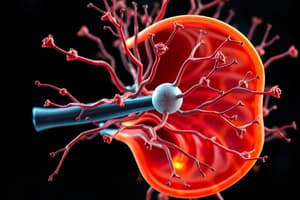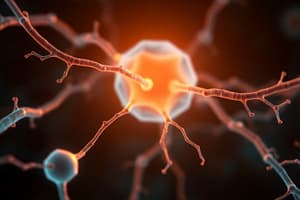Podcast
Questions and Answers
It uses its millions of sensory receptors to monitor changes occurring both inside and outside the body. These changes are called___?
It uses its millions of sensory receptors to monitor changes occurring both inside and outside the body. These changes are called___?
Stimuli
the gathered information is called?
the gathered information is called?
Sensory input
consists of the brain and spinal cord, which occupy the dorsal body cavity and act as the integrating and command centers of the nervous system.
consists of the brain and spinal cord, which occupy the dorsal body cavity and act as the integrating and command centers of the nervous system.
Central nervous system
carry impulses to and from the spinal cord.
carry impulses to and from the spinal cord.
includes all parts of the nervous system outside the CNS. It consists mainly of the nerves that
extend from the spinal cord and brain.
includes all parts of the nervous system outside the CNS. It consists mainly of the nerves that extend from the spinal cord and brain.
carry impulses to and from the
brain
carry impulses to and from the brain
It processes and interprets the sensory input and decides what should be done at each moment—a process called
It processes and interprets the sensory input and decides what should be done at each moment—a process called
It then causes a response, or effect, by activating muscles or glands (effectors) via
It then causes a response, or effect, by activating muscles or glands (effectors) via
These nerves serve as communication lines. They link all parts of the body by carrying impulses from the sensory receptors to the CNS and from the
CNS to the appropriate glands or muscles.
These nerves serve as communication lines. They link all parts of the body by carrying impulses from the sensory receptors to the CNS and from the CNS to the appropriate glands or muscles.
Sensory fibers delivering impulses from the skin, skeletal muscles, and joints are called
Sensory fibers delivering impulses from the skin, skeletal muscles, and joints are called
those transmitting Impulses from the visceral organs are called
those transmitting Impulses from the visceral organs are called
carries impulses from the CNS to effector organs, the muscles and glands. These impulses Activate muscles and glands; that is, they effect
(bring about or cause) a motor response
carries impulses from the CNS to effector organs, the muscles and glands. These impulses Activate muscles and glands; that is, they effect (bring about or cause) a motor response
What are the two subdivisions of motor division?
What are the two subdivisions of motor division?
regulates events that are involuntary, such as the activity of smooth muscle, cardiac muscle, and glands. This subdivision, commonly called the involuntary nervous system,
regulates events that are involuntary, such as the activity of smooth muscle, cardiac muscle, and glands. This subdivision, commonly called the involuntary nervous system,
allows us to consciously, or voluntarily, control our skeletal muscles. Hence, we often refer to this subdivision as the voluntary nervous system.
allows us to consciously, or voluntarily, control our skeletal muscles. Hence, we often refer to this subdivision as the voluntary nervous system.
Means nerve glue, also called glial cells or glia.
Means nerve glue, also called glial cells or glia.
Supporting cells in the CNS are lumped together calls?
Supporting cells in the CNS are lumped together calls?
are the most abundant and versatile neuroglia
are the most abundant and versatile neuroglia
spiderlike phagocytes that monitor the health of nearby neurons and dispose of debris, such as dead brain
cells and bacteria
spiderlike phagocytes that monitor the health of nearby neurons and dispose of debris, such as dead brain cells and bacteria
phagocytes thatdefend CNS cells.
phagocytes thatdefend CNS cells.
abundant star-shaped cells that
account for nearly half of neural tissue
abundant star-shaped cells that account for nearly half of neural tissue
neuroglia that line the central cavities of the brain and the spinal cord. The beating of their cilia helps to circulate the cerebrospinal fluid that fills those cavities and forms a protective watery cushion around the CNS
neuroglia that line the central cavities of the brain and the spinal cord. The beating of their cilia helps to circulate the cerebrospinal fluid that fills those cavities and forms a protective watery cushion around the CNS
neuroglia that wrap their flat extensions (processes) tightly around the nerve fibers, producing fatty insulating coverings called myelin
sheaths
neuroglia that wrap their flat extensions (processes) tightly around the nerve fibers, producing fatty insulating coverings called myelin sheaths
surround neurons in the PNS.
surround neurons in the PNS.
cells line cerebrospinal
fluid–filled cavities.
cells line cerebrospinal fluid–filled cavities.
act as protective, cushioning cells for peripheral neuron cell bodies.
act as protective, cushioning cells for peripheral neuron cell bodies.
What are the two cells in the PNS?
What are the two cells in the PNS?
It is an insulating material produced by oligodendrocytes?
It is an insulating material produced by oligodendrocytes?
also called nerve cells, are highly specialized to transmit messages (nerve impulses) fom one part of the body to another.
also called nerve cells, are highly specialized to transmit messages (nerve impulses) fom one part of the body to another.
The organelles that are particularly abundant in cell bodies
The organelles that are particularly abundant in cell bodies
is the metabolic center
of the neuron. Its transparent nucleus contains a large nucleolus.
is the metabolic center of the neuron. Its transparent nucleus contains a large nucleolus.
Neuron processes that convey incoming Messages (electrical signals) toward the cell body Are
Neuron processes that convey incoming Messages (electrical signals) toward the cell body Are
those that generate nerve impulses and typically conduct them away from the cell body are
those that generate nerve impulses and typically conduct them away from the cell body are
The spaces between myelin sheets
The spaces between myelin sheets
Flashcards are hidden until you start studying
Study Notes
Nervous System Overview
- Sensory receptors monitor internal and external changes; these changes are termed stimuli.
- Collected sensory information is referred to as sensory input.
- The Central Nervous System (CNS) consists of the brain and spinal cord, located in the dorsal body cavity, serving as command and integration centers.
Nerve Impulses and Communication
- Nerves carry impulses to and from the spinal cord and brain, ensuring communication throughout the body.
- Sensory fibers relay impulses from skin, skeletal muscles, and joints; these are known as somatic sensory fibers.
- Visceral sensory fibers transmit impulses from internal organs.
Motor Responses
- The CNS processes sensory input and formulates responses, termed motor output, by activating muscles or glands (effectors).
- The motor division of the nervous system includes two subdivisions:
- Autonomic Nervous System (ANS): Regulates involuntary actions, including smooth muscle, cardiac muscle, and glands.
- Somatic Nervous System: Controls voluntary movements of skeletal muscles.
Supporting Cells in the CNS
- Glial cells, or neuroglia, are essential support cells that outnumber neurons and assist in various functions.
- Astrocytes: Star-shaped neuroglia providing structural support and support for neurons.
- Microglia: Phagocytic cells that defend the CNS by removing debris and pathogens.
- Ependymal Cells: Line brain and spinal cord cavities, aiding in circulation of cerebrospinal fluid (CSF).
- Oligodendrocytes: Wrap around nerve fibers, forming myelin sheaths that insulate axons.
Peripheral Nervous System (PNS)
- PNS includes all nervous system parts outside the CNS.
- Schwann cells in the PNS provide myelin insulation for peripheral nerves.
- Neurons are specialized cells that transmit nerve impulses throughout the body.
- PNS also contains satellite cells, which support and protect neuron cell bodies in ganglia.
Studying That Suits You
Use AI to generate personalized quizzes and flashcards to suit your learning preferences.



